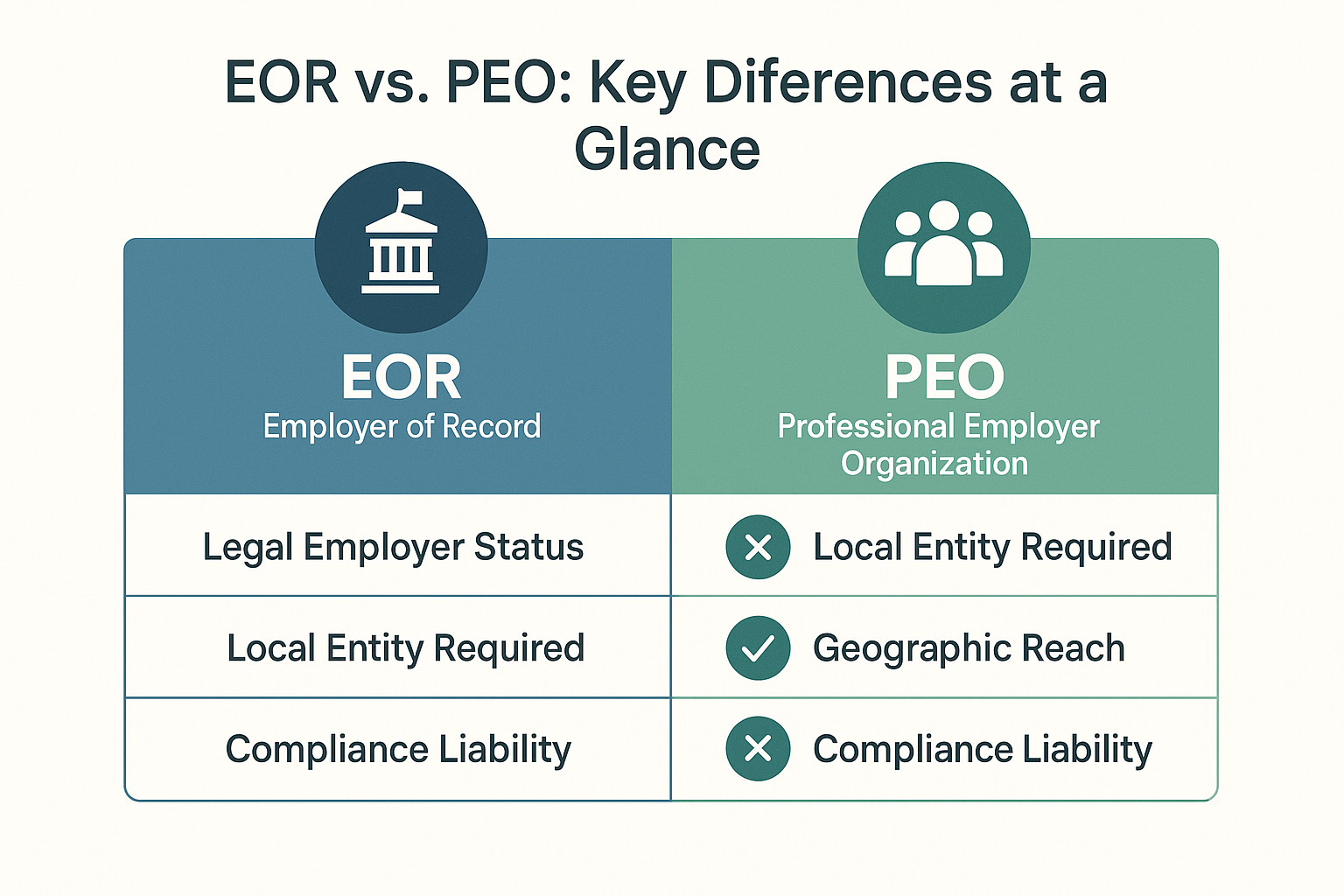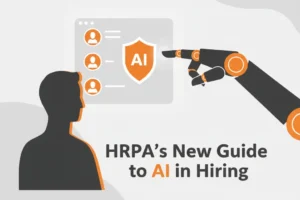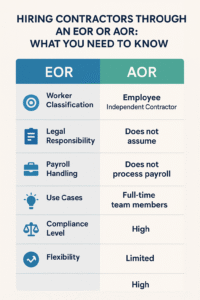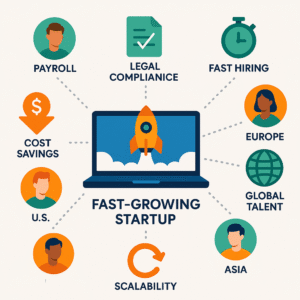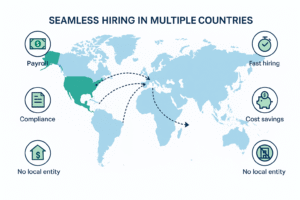Introduction
As businesses grow and expand into new markets, managing HR operations becomes increasingly complex. Two popular solutions to streamline this process are the Employer of Record (EOR) and Professional Employer Organization (PEO). Although similar, they have distinct roles, compliance implications, and benefits. This article provides an in-depth comparison to help HR managers and enterprise decision-makers determine the best solution for their needs.
What is an Employer of Record (EOR)?
An Employer of Record is a third-party entity that becomes the legal employer of your employees in regions where your company lacks a local entity. The EOR handles all employment responsibilities, including payroll, taxes, benefits, and compliance with local employment laws.
Key Features of an EOR
- Legal Employer: Assumes full responsibility for compliance with local employment laws.
- No Local Entity Required: Enables hiring without the need for local incorporation.
- Global Reach: Typically supports hiring in multiple international locations.
Real-World Example of EOR
Imagine a US-based tech firm expanding operations to Europe. Without an existing European entity, setting up offices and payroll would be costly and time-consuming. By using an EOR, they quickly onboard European employees, ensuring compliance with EU employment regulations without forming a local subsidiary.
What is a Professional Employer Organization (PEO)?
A Professional Employer Organization enters a co-employment arrangement, sharing employer responsibilities with your company. Unlike an EOR, your company must already have a legal entity in the locations where the PEO operates.
Key Features of a PEO
- Co-employment Structure: Shares employment responsibilities.
- Comprehensive HR Services: Includes payroll, benefits administration, compliance support, and HR consulting.
- Local Entity Required: Only operates in regions where you have an established presence.
Real-World Example of PEO
A medium-sized company with multiple locations across the United States partners with a PEO to streamline payroll, enhance benefits offerings, and ensure compliance across multiple state regulations. Employees remain under direct operational management but benefit from improved HR administration.
Key Differences Between EOR and PEO
Legal Employer Status
- EOR: Sole legal employer, fully responsible for compliance and liabilities.
- PEO: Co-employer, sharing compliance responsibilities and liabilities with your company.
Entity Requirement
- EOR: No need for a local legal entity.
- PEO: Requires your company to have a local entity.
Geographic Reach
- EOR: Designed for international expansion and remote hiring.
- PEO: Primarily focused on domestic HR administration within your existing operational regions.
Compliance and Liability
- EOR: Fully responsible for compliance, significantly reducing your risk exposure.
- PEO: Shares compliance responsibilities; your company still holds significant accountability.
Historical and Published Data
According to the National Association of Professional Employer Organizations (NAPEO), companies utilizing PEOs experience 7-9% faster growth and 10-14% lower employee turnover compared to their peers. The global EOR market, valued at approximately $5 billion in 2024, is projected to nearly double by 2030, highlighting increasing adoption and confidence in EOR services globally.
When to Choose an EOR?
- Expanding internationally without local incorporation.
- Hiring remote international employees rapidly.
- Reducing compliance risk significantly in unfamiliar jurisdictions.
When to Choose a PEO?
- Streamlining HR operations domestically.
- Leveraging group benefit plans and HR expertise.
- Supporting multi-state compliance efficiently.
Pros and Cons at a Glance
Employer of Record (EOR)
Pros:
- Rapid international hiring.
- No entity setup required.
- High compliance assurance.
Cons:
- Less control over employment terms.
- Higher long-term costs at scale.
Professional Employer Organization (PEO)
Pros:
- Comprehensive domestic HR management.
- Enhanced employee benefits.
- Cost-effective at scale.
Cons:
- Requires a local entity.
- Shared compliance liability.
Frequently Asked Questions (FAQ)
What is the main difference between an EOR and PEO?
The primary difference is employer status. An EOR is the sole legal employer of the workforce, while a PEO shares employment responsibilities with your company.
Can I switch from EOR to PEO or vice versa?
Yes. Companies often transition from an EOR to a PEO as they establish local entities, or from PEO to EOR when expanding internationally.
Are EOR and PEO services legally compliant?
Yes, both EOR and PEO are legitimate and compliant solutions, provided you choose reputable providers that adhere to local laws and regulations.
What type of company benefits most from using an EOR?
Companies expanding internationally without existing foreign entities or those hiring remote global employees benefit significantly from EOR services.
Are there minimum employee requirements for PEO and EOR services?
PEOs often have minimum employee requirements (typically 5-10 employees), whereas EOR services usually do not have minimum thresholds, making them more flexible for small-scale international hires.
Conclusion
Choosing between an Employer of Record and a Professional Employer Organization depends on your company’s specific needs and growth strategy. If you’re expanding internationally or managing remote international teams, an EOR provides rapid compliance and flexibility. Conversely, for established companies seeking comprehensive HR support domestically, a PEO can offer substantial benefits, cost savings, and reduced administrative burdens.
Evaluate your current business model, geographic expansion plans, HR capacity, and compliance requirements to determine the best fit. Both models provide robust solutions to simplify and enhance your HR operations, ultimately facilitating sustainable business growth.
Need help improving your hiring process? Contact Divino Solutions today for science-backed recruitment solutions or check out how to simplify recruitment or The Bias of Interviews: Are You Just Hiring a Smile?
Sources
- National Association of Professional Employer Organizations (NAPEO)
https://www.napeo.org/what-is-a-peo/about-the-peo-industry/industry-statistics - Velocity Global (comprehensive information on EOR and PEO solutions)
https://velocityglobal.com/resources/peo-vs-eor-whats-the-difference/ - Globalization Partners (global employment solutions and insights)
https://www.globalization-partners.com/employer-of-record-vs-peo-whats-right-for-your-company/ - Remote.com (leading provider of global EOR solutions and employment guides)
https://remote.com/blog/peo-vs-eor - U.S. Chamber of Commerce (official business resource explaining co-employment structures)
https://www.uschamber.com/co/run/human-resources/peo-vs-eor - ADP (trusted payroll and HR solutions provider, explanation of co-employment and EOR)
https://www.adp.com/resources/articles-and-insights/articles/e/employer-of-record-vs-peo.aspx - EY (Ernst & Young) (report on international employment solutions and market data)
https://www.ey.com/en_gl/workforce/employer-of-record-services
